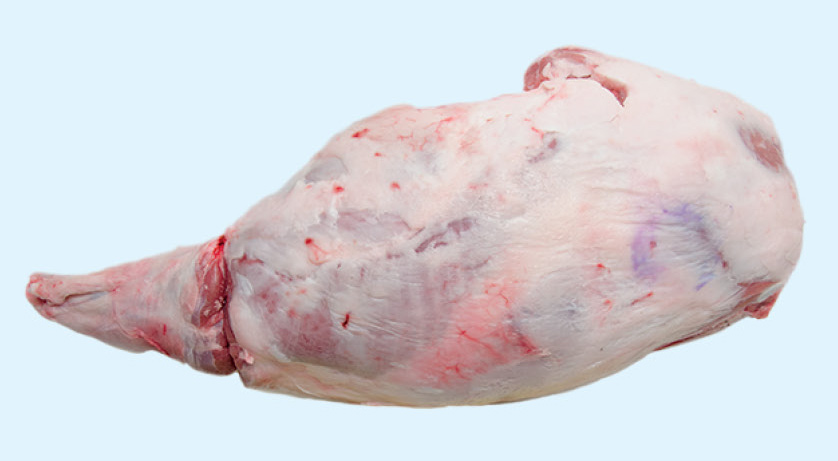Choosing a Leg o’ Lamb
There are four ways to prepare a big ol’ leg o’ lamb: bone-in, boneless, butterflied, or cut apart into cubes for spiedies (page 289).

Bone-in With a bone-in leg (below), the thick end can be cooked to a perfect medium-rare, while the narrow end will be closer to well-done. There’s always someone who doesn’t like red or pink meat, so this may suit your guests.
If you are going to cook a bone-in leg, have your butcher remove the shank, shown in the picture below. The bone is hard to cut through at home, but it can be done with a shiny new hacksaw blade. The shank is the end that tapers to the ankle; it is tough, laden with leathery tendons, and always cooks well-done because it is so narrow. Save a few in the freezer and use them to make stew.
Also ask your butcher to remove the aitchbone, the part of the pelvic bone that has the socket into which the ball of the thighbone fits. In the photo below left, you can see the aitchbone in the lower left, the ball of the femur (thighbone) peeking out of the thigh, and the tibia and fibula (shank) in the upper left. Getting it out makes carving the finished meat a lot easier and unless you know what you are doing, it can be a real pain to remove at home.

Boneless Roast You can buy boneless legs, and that’s what I usually do. A boneless leg comes rolled and tied into a more symmetrical shape, so it cooks more evenly and is easier to carve with no bones in the way. You can do it yourself, but it is tedious. Make sure you ask the butcher to remove the ugly-tasting gland located in the triangle of fat near the knee.
You can even cut the string, open the leg, and stuff the leg with dried fruits and/or seasoned bread crumbs, and then tie it up again. Prunes are a classic stuffing.
Butterflied Another great way to cook leg of lamb is to bone it but not roll it up. When you are done, you’ll have a big flap of meat, perhaps 2 by 2 feet and 1 to 4 inches thick. The exterior will be fairly even and smooth, but the inside will be irregular and have mountains and valleys from the deboning effort. These nooks and crannies are perfect places to hide the flavors of Dolly’s Lamb Rub (page 169), but they make it hard to cook it evenly. If you reverse sear it, you’ll get more even cooking and lots of great crispy brown surface.